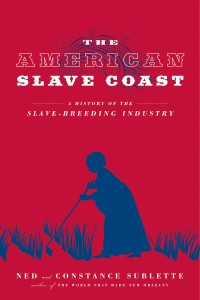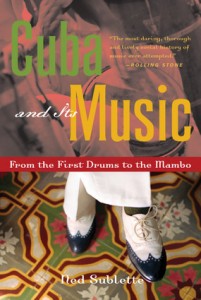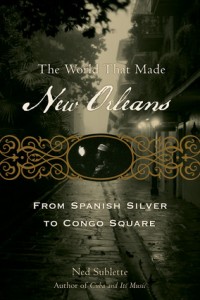Ned and Constance Sublette have been expanding each other’s knowledge and consciousness of history since they met in 1975. They began working on The American Slave Coast: A History of the Slave-Breeding Industry in 2010 when Ned was in residence at Washington College’s C.V. Starr Center for Study of the American Experience in Chestertown, Maryland. “That fellowship was an absolutely transformative experience for us,” says Ned. “The Starr Center has been the laboratory for some of the most dynamic work being done about the history of the early republic.”
“This book represents our thought,” says Ned. “Morning, noon and night, we talked out pretty much every nuance of the text over the years of researching and writing, and we can’t always remember who connected the dots first.” Constance’s interest in biography influenced the way historical figures enter and exit the narrative, while Ned was more focused on the financial/business/economics aspect. For the past 15 years, slavery and the African diaspora have been central to their work.
 You wrote The American Slave Coast for a general—as opposed to academic—audience. Why did you think this was important?
You wrote The American Slave Coast for a general—as opposed to academic—audience. Why did you think this was important?That’s who we always write for: the general literate reader. That’s where the passion is. We’re driven to answer the historical questions that we ourselves have—How did this happen? Who did it? Why?—which in turn come out of ongoing conversations with our friends, many of whom take a very real interest in understanding American history but few of whom are American historians. It’s been an empowering process for us—as well as a humbling one—to take charge of constructing an overarching history of our own country, and it’s been a great privilege to be able to take these years to study the documents in depth. We also feel a heavy responsibility to the people whose story we’re telling.
American history is populated with brilliant minds, and some of our sharpest scholars have written revelatory works about slavery in the last few years. But we’re not doing what they’re doing, and we haven’t seen a book that does what this does. Starting with the blunt, horrible truth that American slavery was a slave-breeding industry, we’ve applied that understanding to the large arc of American history.
NS: We felt we had no choice. It was our duty to write this book. This story had to be told. We as a nation haven’t faced up to the reality of slavery, the story is still not well known, and people want to know about it, so let’s talk about it. As Americans, we feel ashamed that we had to write it, and in a very real sense, it’s unfinished, because the crime of slavery still traumatizes our society in an active way today.
Slavery in the United States was a slave-breeding system. This story of national expansion premised on the reproduction of captive humans who were labor, merchandise, and collateral, all at once, is horrific, and it’s basic to the story of our development as a nation. It’s not a sidebar to American history, it’s central. It’s particularly important, because despite the best work of scholars, American history has always come up against a disinformation process that has sanitized it. But sanitized history won’t explain how we got to this mess we have today.
CS: For me, it was for the women—those millions of nameless women who were mandated to be constantly pregnant, even if it killed them, yet had no legal right to their own children. This book is for them.

 NS: The American Slave Coast comes directly out of the work we were already doing. The World That Made New Orleans contains a chapter called “The Slave-Breeding Industry,” which lays some of this story out in short form. The book has been very successful, but we’ve noticed that very little of the commentary mentions that chapter, so we thought, okay, time to break that out and investigate it more deeply. Cuba and Its Music resulted from my years of work in Cuba, where there was a much different system of slavery. It forced us to understand that the slave-breeding industry was truly a case of American exceptionalism. People have said that my other books have “a-ha! moments” that gave them a new perspective on a history they thought they knew. We think this book tells a number of stories about American history and its major players that Americans don’t know.
NS: The American Slave Coast comes directly out of the work we were already doing. The World That Made New Orleans contains a chapter called “The Slave-Breeding Industry,” which lays some of this story out in short form. The book has been very successful, but we’ve noticed that very little of the commentary mentions that chapter, so we thought, okay, time to break that out and investigate it more deeply. Cuba and Its Music resulted from my years of work in Cuba, where there was a much different system of slavery. It forced us to understand that the slave-breeding industry was truly a case of American exceptionalism. People have said that my other books have “a-ha! moments” that gave them a new perspective on a history they thought they knew. We think this book tells a number of stories about American history and its major players that Americans don’t know.
CS: After leaving grad school I continued to read history while beginning to explore approaches that could bring my historical interests into fiction, back in the era when attacks on contraception and Roe v. Wade began. I worked at the Fraunces Tavern Museum for a time, which allowed me to immerse entirely in early American history.
More importantly, through interactions with the museum’s visitors, I learned how differently our public history reads to a white man than it does to African Americans, young girls and women. For the former, our history is a triumphalist stroll; for the latter it’s a blank. Where are we, they asked, in this story? I began to feel that revealing this history would be more useful for readers—more honest—than employing history for my own imagined plots, filled with imaginary characters.
Besides documents, physical spaces were important. We visited as many of the sites and sacred places named in the book as we could—in Virginia, Maryland, the District of Columbia, North Carolina, South Carolina, Georgia, Florida, Alabama, Mississippi, and Louisiana. It’s a strong experience to walk the short distance from the church in Richmond where slave-owner Patrick Henry mock-stabbed himself with a letter opener and said, “Give me liberty—or give me death!” to the ground where Gabriel and his co-conspirators were hung a quarter-century later for planning an uprising that was never carried out. Or to visit the Forks of the Road in Natchez, the site of the second largest slave market behind New Orleans, where local initiative has created a memorial of manacles set in concrete, across the street from an auto repair shop. Or the site of Africatown in Mobile, where the last African captives brought to the United States (in 1860) established a community.
NS: Writing this book revolutionized our understanding of our history. We hope it will do the same for the reader. The larger picture of how Virginia versus South Carolina functioned can only come after you’ve worked it out a data point at a time. We were fascinated to learn myriad local histories: the basic narrative drive of the book is the state-by-state creation of what would become the United States—Florida, Virginia, Maryland, South Carolina, Louisiana, Georgia—and how the organization of each new territory affected the slavery industry.
CS: One thing that—maybe we didn’t learn this, since we already knew it, but it was brought home to us at every moment—no matter how bad you thought slavery was, it was even worse than that.
—compiled by Meaghan Miller
The American Slave Coast officially published on October 1, 2015. It is available wherever books and e-books are sold, including our website.
Ned and Constance Sublette are touring to promote The American Slave Coast throughout October and November. Read an excerpt here.
2 Comments
[…] Behind the Scenes with authors Ned and Constance Sublette […]
Great book!